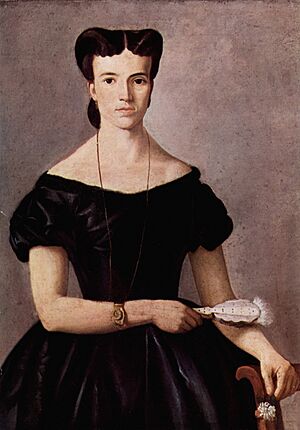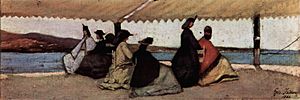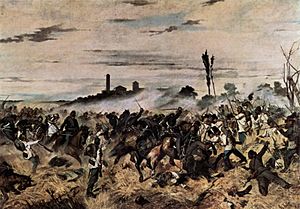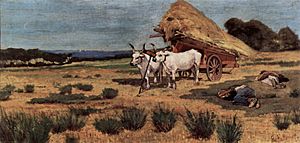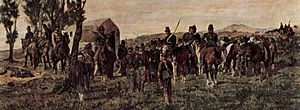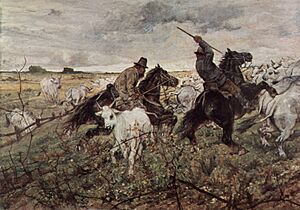Giovanni Fattori facts for kids
Quick facts for kids
Giovanni Fattori
|
|
|---|---|
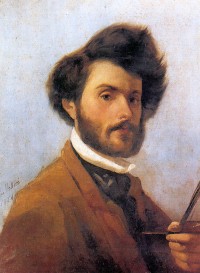
|
|
| Born | 6 September 1825 |
| Died | 30 August 1908 (aged 82) |
| Nationality | Italian |
| Known for | Painting |
| Movement | Macchiaioli |
Giovanni Fattori (born September 6, 1825 – died August 30, 1908) was a famous Italian artist. He was one of the main leaders of a group of painters called the Macchiaioli.
At first, he painted historical scenes and military subjects. Later, he became one of Italy's best plein-air painters. This means he painted outdoors, directly from nature. He created beautiful landscapes, scenes of country life, and military moments. After 1884, he also spent a lot of time making etchings.
Contents
About Giovanni Fattori
His Early Life and Art Training
Giovanni Fattori was born in Livorno, Italy, into a family that wasn't rich. He had a basic education, and his family first wanted him to work in business. But Giovanni was very good at drawing. So, in 1845, he became an apprentice to Giuseppe Baldini, a local painter.
The next year, he moved to Florence. There, he studied at the Academy of Fine Arts. But he was more interested in reading exciting historical novels, especially those about the Middle Ages, by authors like Walter Scott.
In 1848, he paused his studies to help a movement against Austrian rule. He delivered messages for the Partito d'Azione. His family stopped him from joining the army. In 1850, he went back to the Academy in Florence. He always carried small notebooks to draw and write down his ideas. Some of his later etchings were based on these early sketches.
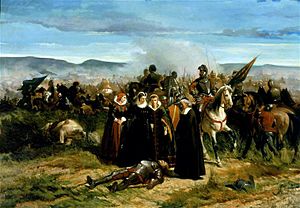
His First Paintings (Before 1860)
Giovanni Fattori took a while to become a mature painter. His first paintings, mostly portraits and historical scenes, were made in the early 1850s. These were influenced by his teacher, Giuseppe Bezzuoli. In 1851, he showed a painting called Ildegonda at an exhibition.
Around 1857, another artist named Enrico Pollastrini introduced him to the style of Ingres. This influenced Fattori's historical paintings. One of his best historical works was "Maria Stuarda" (Mary Stuart at the battlefield of Langside), painted between 1858 and 1860.
In the early 1850s, Fattori often visited the Caffè Michelangiolo in Florence. This was a popular spot where artists talked about art and politics. Some of these artists visited Paris in 1855 and discovered the Barbizon school painters. They brought back the exciting idea of painting outdoors, directly from nature.
In 1859, Fattori met Giovanni Costa, a landscape painter. Costa inspired him to join his friends and start painting realistic landscapes and everyday scenes outdoors. This was a big moment for Fattori! He became part of the Macchiaioli group.
The Macchiaioli painters used "macchia" (spots or patches) of color to capture light and shadow. Their style was similar to the Impressionists in France, and they are seen as early pioneers of modern art. Like the Impressionists, they were criticized for their paintings not looking "finished" enough.
In 1859, Fattori won a competition for a patriotic battle scene. His painting was called Il campo italiano dopo la battaglia di Magenta (The Italian Camp at the Battle of Magenta). The prize money allowed him to marry Settimia Vannucci in July 1859 and settle in Florence.
His Middle Period Paintings (1861–1883)
Fattori's mature paintings combined painting outdoors with natural light and using his sketches to create larger works in his studio.
From 1861 to 1867, he mostly stayed in Livorno to care for his wife, who was very sick. During this time, he painted country people, scenes of rural life, and some portraits. These works showed his skill with the "macchia" technique, using strong contrasts of light and shadow.
In 1864, he showed four more paintings at an exhibition in Florence. In his landscape painting La Rotonda di Palmieri (Palmieri's round terrace) (1866), he used simple shapes and colors to create the structure of the painting.
In late 1866, he moved to a bigger studio in Florence. He still received requests for large battle scenes from the Italian unification (Risorgimento). A famous painting from this time is the Storming of the Madonna della Scoperta, which shows a moment from the Battle of San Martino (1859).
After his wife passed away in March 1867, he spent the summer in Castiglioncello with art critic Diego Martelli. Martelli was a key thinker for the Macchiaioli group. Fattori worked with painter Giuseppe Abbati and created many outdoor landscapes and studies of country life. He focused on strong designs, simple shapes, and bright light in these paintings. One example is Pause in the Maremma with Farmers and Ox-cart (1873–75).
Fattori won an award in 1870 for his battle scene Prince Amadeo Feritio at Custoza. In 1872, he traveled to Rome and made studies for Horse Market at Terracina. This painting won a bronze medal at the World Exhibition in Vienna in 1873 and again in Philadelphia in 1876. His trip to Rome also inspired Roman Carts (1872-1873).
In 1875, Fattori visited Paris, where he showed his work Repose. Through Diego Martelli, who lived in Paris, he met many French artists. But he wasn't very impressed by Impressionist art. He preferred the Barbizon school artists and greatly admired Édouard Manet and Corot.
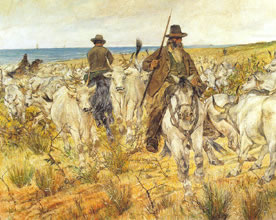
Fattori started giving private painting lessons. From 1869, he also taught at the Florentine Academy. One of his later students was Amedeo Modigliani. However, he faced money problems because his battle paintings didn't sell well. He even lost some of his property because he couldn't pay his taxes. This, along with a leg injury, made him feel sad. In 1878, he sent two paintings to an exhibition in Paris, but he was too poor to go himself. His disappointment showed in his art from the late 1870s, which became more realistic and sometimes harsh.
In the 1880s, he mainly painted country scenes, like horses and cattle. He visited the Corsini family's estate in Maremma in 1881 and 1882. This led to a series of paintings of cowherds, some of which were shown in Venice in 1887.
Later Paintings and Etchings (1884–1908)
From 1875 onwards, Fattori started making many drawings and, from 1884, a lot of etchings. These were well-received at exhibitions in Florence (1886) and Bologna (1888). His etchings were new and creative in their style and composition.
In 1884, he created an album with 20 original lithographs. In 1888, he became a Professor of Drawing at the Academy of Florence and also taught Figure Study at the School of Architecture.
His outdoor sketches, often painted on small wood panels, were used to create larger paintings of country subjects. Examples include Branding of the Colts in the Maremma (1887) and Cowboys and Herds in the Maremma (1893). These large paintings have a dramatic feel and a sense of wide-open space.
Fattori showed his work at exhibitions in Cologne (1889), Bologna, Milan (1891), Turin (1900), and Florence. He also had a painting, The Brush Gatherers, at an Italian exhibition in London. In Paris, he received an honorable mention in 1889 and a gold medal at the Exposition Universelle in 1900 for his etching 'Bovi al Carro' (Oxen to the Cart).
In 1891, Giovanni Fattori married for the second time, to Marianna Bigozzi Martinelli. Even though he worked hard, he lived in poverty. Money problems and growing debt forced him to give private lessons again. He couldn't even afford frames for his paintings, so he missed an exhibition in Dresden in 1896.
He also started drawing illustrations for books, like I promessi sposi by Manzoni (1895), and for a funny newspaper called Fiammetta (1896).
In 1900, he became a member of the Accademia Albertina in Turin. After his second wife passed away in 1903, Fattori married again in 1906, to Fanny Marinelli.
In his old age, Fattori felt very disappointed with how Italy had changed after its unification. He kept teaching at the Academy but preferred old traditions over new ideas. He was known for being honest and straightforward. Fattori didn't like the new art styles some of his students were exploring in the 1890s, like Neo-impressionism (called Divisionismo in Italy). In 1891, he argued against pointillism.
Around 1903, he wrote about his sadness and disappointment. He passed away in Florence on August 30, 1908. He was buried in the loggia near the church Santuario della Madonna di Montenero in the village of Monte Nero.
Giovanni Fattori's Legacy
Giovanni Fattori is seen as the most important member of the Macchiaioli group. His art often shows military subjects, but usually not actual battles. Instead, he painted soldiers in camps, gathering, or resting. He also created sensitive portraits, landscapes, country scenes, and horses.
However, towards the end of his life, he didn't keep up with new art trends. This led to his art becoming less popular and caused his money problems. While his fellow artists respected him, the general public didn't recognize him as much.
You can see his work in many places, including:
- Galleria Nazionale d'Arte Moderna in Rome
- Pinacoteca metropolitana di Bari
- Galleria Civica d'Arte Moderna e Contemporanea in Turin
- Pinacoteca di Brera in Milan
- Galleria d'Arte Moderna in Palazzo Pitti in Florence
- Dunedin Public Art Gallery in New Zealand
- Museum of Fine Arts in Boston, North America
His hometown honors him with the Museo Civico Giovanni Fattori in Livorno.
Images for kids
-
Self-Portrait (1854), oil on canvas, 59 x 46.5 cm, Florence, Galleria d'Arte Moderna
-
Mary Stuart at the Camp of Crookstone, 1859–61, oil on canvas, 76 x 108 cm, Palazzo Pitti, Florence
-
Cowboys of the Maremma Driving the Herds, 1893, oil on canvas, 200 x 300 cm, Livorno, Museo Civico Fattori
See also
 In Spanish: Giovanni Fattori para niños
In Spanish: Giovanni Fattori para niños
- Macchiaioli
- Landscape art


